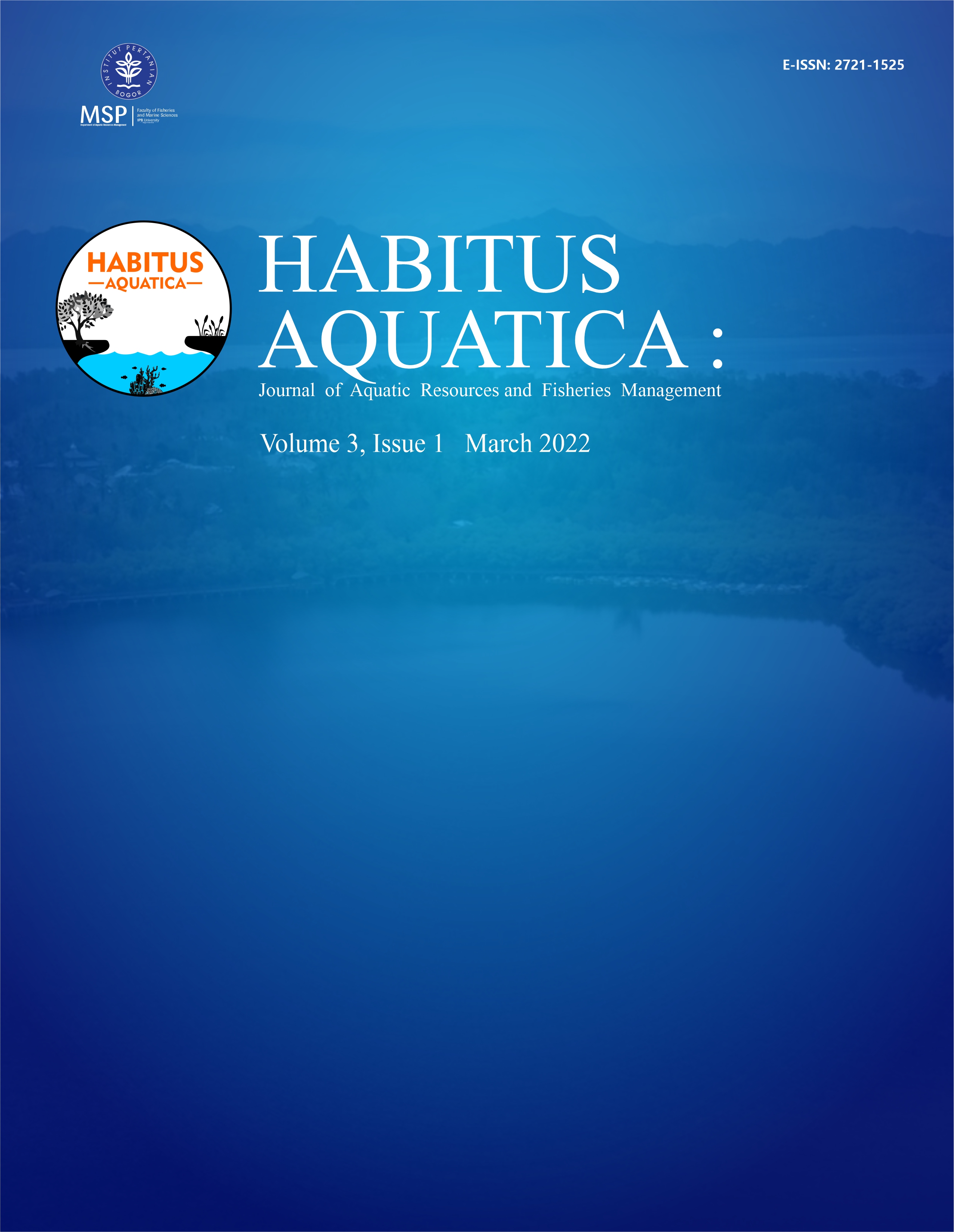Occurrence of Isoyake in Kelp Beds of Saccharina japonica in Primorskii, Far-East Russia
Fenomena Isoyake di Hamparan Rumput Laut Saccharina japonica di Primorskii, Far-East Rusia
Abstract
A decline in the abundance of the seaweed Saccharina japonica has occurred in Primorskii, far-eastern Russia. Most of the seaweed has disappeared at this location, resulting in a barren coastline known as Isoyake. Field surveys conducted from 1975 to 2015 in Valentin Bay revealed a significant decline in the seaweed population. This decline correlated with fluctuating water temperatures. In the period 1980 to 1990, water temperatures tended to be lower, then increased in the period 2000–2010, and again decreased in temperatures in 2010–2019. Despite lower temperatures after 2010, Isoyake persisted. These findings emphasize the need for continued monitoring and deeper investigation of the environmental and ecological drivers behind Isoyake, with implications for conservation and sustainable management of seaweed resources in far-east Russia.
Downloads
References
Agatsuma Y. 1997. Ecological studies on the population dynamics of the sea urchin Strongylocentrotus nudus. Science Reports of the Hokkaido Fisheries Experimental Station. 51:1–66.
Akaike S, Kikuchi K, Monma H, Monma H, Nozawa Y. 1998. Effects of adding nitrogen and phosphorus fertilizer on the growth of sporophytes of Laminaria ochotensis Phaeophyta in the field. Aquaculture Science. 46:57–65 (in Japanese with English Abstract).
Akaike S, Tsuda F, Kuwahara H. 2002. Formation and maintenance of the natural Laminaria bed on the coast of Iwanai, Hokkaido, Japan. Scientific Reports of the Hokkaido Fisheries Experimental Station. 63:41–54. (in Japanese with English Abstract)
Ayling AM. 1981. The role of biological disturbance in temperate subtidal encrusting communities. Ecology. 62:830–847.
Fujita D. 1989. Marine algal distribution in the ‘Isoyake’ area at Taisei, Hokkaido. Nanki Seibutsu. 31:109–114. (in Japanese)
Galanin D, Repnikova A. 2014. Present situation of fisheries research on kelp in southern Sakhalin, Russia. Fisheries Engineering. 51:65–69. (in Japanese with English Abstract)
Hoshikawa H, Akino H, Takahashi K, Tsuda F. 2018. Effect of water temperature from autumn to spring on biomass and density of the kelp Saccharina japonica var. religiosa in June at Otaru, Hokkaido. Fisheries Engineering. 55:123–133.
Kawai T, Galanin D, Krupnova T, Yotsukura, N. 2015. Harvest and cultivation of Saccharina japonica in Northern Hokkaido, Japan, and south Sakhalin and Primorye, Russia: A review. Algal Resource. 8:155–163.
Kawai T, Galanin D, Tskhay Z, Latokovskaya E, Nagai N, Yotsukura N. 2014. Relationship between occurrence of kelp species and water temperature in northern Hokkaido, Japan and southern Sakhalin, Russia. Algal Resource. 7:107–116.
Kirihara S, Nakamura T, Notoya M. 2003. Effect of water temperature on the growth Laminaria japonica (Laminariales, Phaeophycea) at the coast of Shiriyazaki, Shimokita Peninsula, Japan. Suisanzoshoku. 51: 273–280.
Krupnova T. 2012. Forecasting kelp stocks of Laminaria (Saccharina japonica) with a lead time of two years. Report of the TINRO. 170:30–44.
Kuribayashi T, Abe T, Montani S. 2017. Historical δ15N records of Saccharina specimens from oligotrophic waters of Japan Sea (Hokkaido). PLOS ONE. 12:https://doi.org/10.1371/journal.pone.0180760
Nabata S-I, Abe E, Kakiuchi M. 1992. On the ‘Isoyake’ condition in Taisei-cho, southwestern Hokkaido. Scientific Reports of the Hokkaido Fisheries Experimental Station. 38:1–14 (in Japanese with English Abstract).
Taniguchi K, 1996. Fundamentals and practice of marine afforestation. Japanese Journal of Phycology. 44:103–108.
Tegner MJ. 1989. The feasibility of enhancing red sea urchin Strongylocentrotus franciscanus stocks in California: an analysis of the options. Marine Fisheries Review. 51:1–22.
Yotsukura N, Kawashima S, Kawai T, Abe T. 2008. A systematic re-examination of four laminaria species: L. japonica, L. religiosa, L. ochotensis and L. diabolica. Journal of Japanese Botany. 83:165–176.
Copyright (c) 2024 Habitus Aquatica

This work is licensed under a Creative Commons Attribution-ShareAlike 4.0 International License.
Authors submitting manuscripts should understand and agree that copyright of manuscripts of the article shall be assigned/transferred to Habitus Aquatica Journal. This work is licensed under a Creative Commons Attribution-ShareAlike 4.0 International License (CC BY-SA). Therefore, Authors and Readers are permitted to share — copy and redistribute the material in any medium or format, and adapt — remix, transform, and build upon the material for any purpose. However, they must give appropriate credit, provide a link to the license, and indicate if changes were made. If you remix, transform or build upon the material, you must distribute your contributions under the same license as the original.


















